Ultraviolette electric bike prototype review, test ride
Bengaluru-based start-up Ultraviolette wants to outperform 200-250cc motorcycles with its upcoming EV. Having ridden the final prototype, we can confirm that they’re on track to do just that.
Published on Feb 26, 2019 05:57:00 PM
89,310 Views
Follow us on
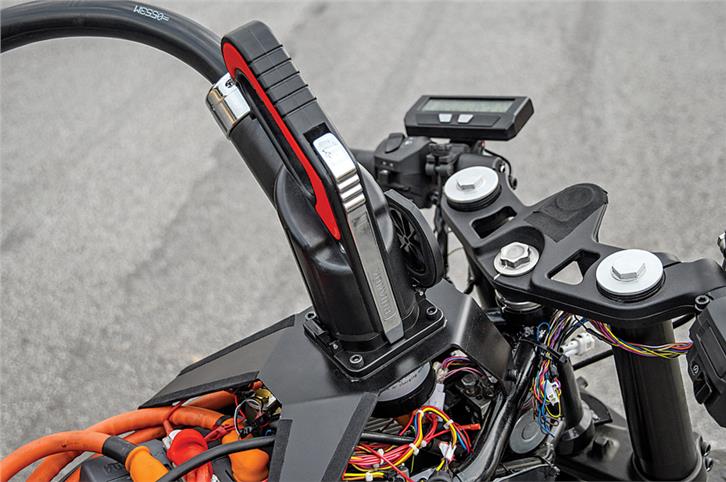
Charging socket will replace the fuel cap.
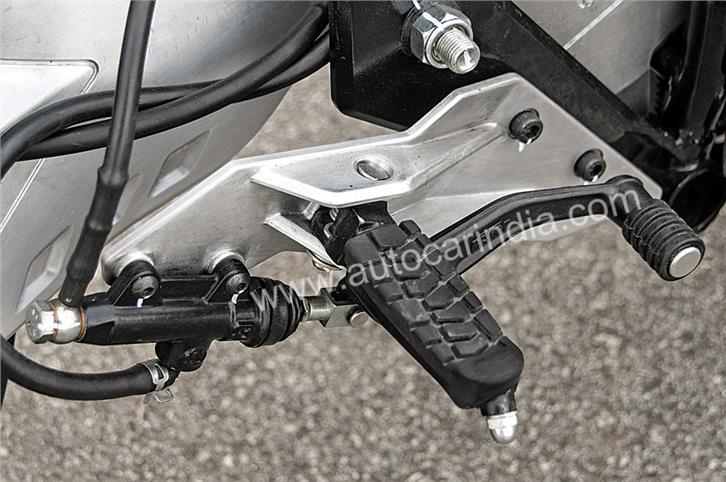
Plenty of aluminium bits all around.

This teaser image hints at the final design — expect a sharp, fully faired affair.
Wind the clock back to early December 2017 and I knew just as much about Ultraviolette Automotive as you probably did, which was exactly nothing. However, that changed when the company made an attention-grabbing announcement that they’d received investment from TVS Motors. Another similar announcement was made eight months later, this time that TVS was increasing the stake from 15 percent to about 25. Beyond that, however, there’s been complete radio silence.
Ultra who?
All that we’ve known so far is that Ultraviolette is working on an electric motorcycle that aims to beat the best 200cc motorcycles. Then, out of the blue a couple of weeks ago, an email popped into my inbox asking if I wanted to come experience a Stage 4, production-ready prototype of the Ultraviolette EV. Emails like this are typically met with a big scoop of scepticism – every third college graduate seems to be building an EV these days, each with grander claims than the one before it. But this time around, the only questions I had were, ‘when and where’. When a giant like TVS puts its money into an otherwise completely unknown entity, there’s bound to be magic brewing behind the curtains.
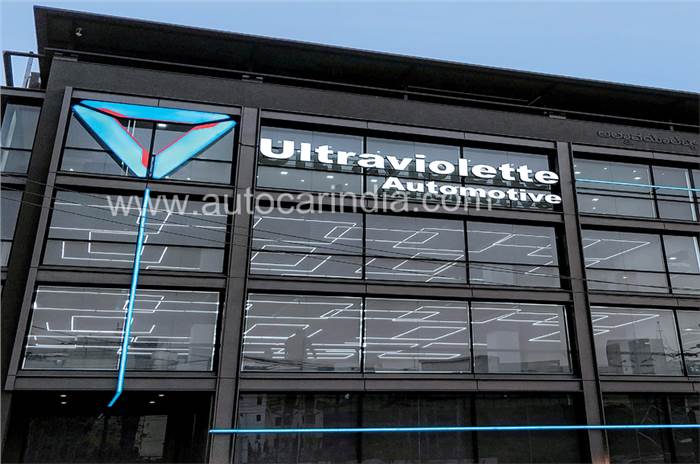
You know things are serious when you pull up at Ultraviolette’s swanky, four-storey establishment, which, funnily enough, is just 2.5km down the road from the Ather showroom in Bengaluru. We are, effectively, the first outsiders to set eyes on the inner workings of the company, Ultraviolette’s founders tell us. These two affable 32-year-olds, Narayan Subramaniam and Niraj Rajmohan, have known each other since school and went their separate ways after engineering college. The duo reunited to form Ultraviolette in 2015, after years of collective experience with multinationals like VW, Toyota, Mahindra Two Wheelers and Yahoo.
Target acquired
Ultraviolette Automotive has come a long way since its early days of a two-man operation based out of a terrace in Koramangala. Today, the company employs 50 people, many who come from senior positions in the auto, tech and aerospace industries. That’s a clever approach, because having technical expertise from industry leaders, including the likes of Honeywell, Phillips, Bosch, Honda, TVS, Bajaj and Royal Enfield, is key when you want to start an automobile company from scratch.
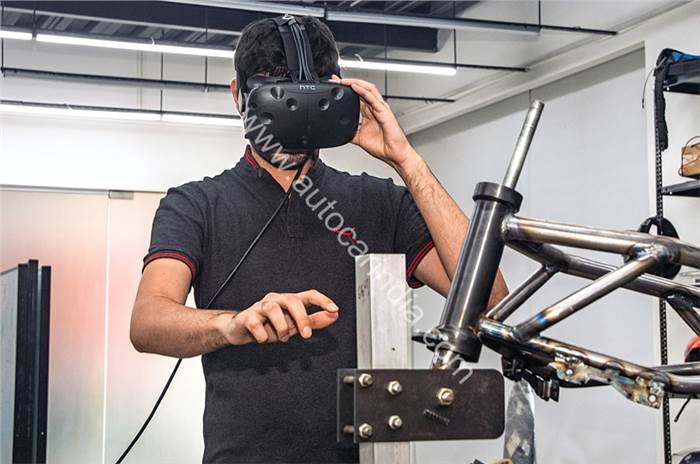
So that’s a brief on the company, but what about the bike? Perhaps the more pertinent question is, why this bike? The founders say that their primary goal is to shatter the misconceptions created by the flood of, erm, let’s call them substandard EVs that India has seen so far. The priority was to prove that electric vehicles can outperform their internal combustion counterparts; so that ruled out segments like scooters and commuters where performance isn’t of most importance. On the other extreme, building an expensive sports bike was pointless as well because that would position it out of reach for almost everyone. That’s how the company zeroed in on the middle ground, a premium space that has been growing rapidly over the years – the 200cc segment. In that space, the crosshairs were trained squarely at the potent KTM 200 Duke.
Nearly everything on this machine, save for the individual battery cells that make up the battery pack, is an in-house affair; those come from one of the world’s top four suppliers. The trellis frame, motor, battery pack, battery management system and connected features have all been developed and fine-tuned within the company headquarters. Naturally, I haven’t been given all the specs at the moment, but what has been shared is certainly very impressive.
Attack mode
For starters, you need a pretty powerful electric motor to beat the likes of a KTM 200 Duke in a straight line. The company had to develop their own because there just aren’t that many options out there with this performance level, aside from highly specialised (read expensive) solutions typically used in the aerospace industry. Narayan and Niraj tell me they’ve managed to keep the motor air-cooled and still extract a peak power of about 25kW. This is huge, compared to the 5.4kW peak the Ather 450 (a genuinely quick EV in its own right) can manage. Peak motor torque is in the ballpark of a jaw-slackening 90Nm, which is more than what you get in some small petrol hatchbacks!
The bespoke trellis frame uses the motor as a stressed member and the packaging of the battery pack is surprisingly slim. There’s a lot of propriety stuff going on in there that allowed the engineers to keep the size and weight of the battery pack in check. They’re not comfortable showing it all off just yet, so I never got to peek behind the big sheets of black plastic along the sides. Once the production bike wears its full fairing, it will get wider by about six inches, but I suspect this bike will still be nice and svelte around the waist.
Electric bikes, at least the quick and practical ones, conjure up mental pictures of fat and heavy battery packs, but there wasn’t any of that here. I got to briefly ride the prototype around the Meco Kartopia go-kart track and just swinging a leg over was enough to tell that this is a light machine. In this stripped-down form, the bike weighs about 138kg and the company says that final weight, with all the bodywork, will be about 150kg – roughly the same as a KTM 200 Duke, then. Serious efforts have gone into achieving this target. The frame, for example weighs 11kg, which is 3kg less than a KTM frame. There’s generous use of aluminium all around and the final bike’s wheels will also be 1kg lighter.
Into the future
Sitting on a naked prototype is a strange experience. There is no bodywork to hold on to and then there’s the constant thought bouncing around your head that this is the only example of its kind in existence. Consider just how much time, money and ingenuity has gone into this prototype and it’s impossible to put a price on just how valuable it is. I simply cannot drop this bike.
With all that torque, I was more than a little nervous about how sensitive the throttle (we should probably stop calling it that now) would be. Thankfully, the full fury of pulling power is tempered well and the response to turning the accelerator open is smooth and drama-free. You can tell that there’s some serious torque restriction happening at the initial moments of travel. You aren’t going to be popping power wheelies, but after the bike moves forward a bit, it surges ahead like it was stung by a bee.

This e-motorcycle has no gearbox or clutch, you just twist the throttle and go. The proto wasn’t running a speedometer, but I reckon it must have been close to 90kph before we ran out of straight at the go-kart track and the bike was still accelerating with determination. The team tells me that the best they’ve achieved is a Vbox-tested 0-100kph time of 7.8sec and a top speed of 142kph. From what I experienced, that feels about right – this is proper 200 Duke baiting, nay, beating performance.
The motor is as smooth as you’d expect, aside from a tiny bit of judder as you roll off, which I’m told is because of the hill-hold system. At speed, the bike makes a rather loud whine, which is supposedly down to the gears in the reduction ratio. However, the final bike is expected to be quieter as it will use forged gears which mesh together more efficiently. A chain for the final drive also adds to the noise, but the team decided to go with this instead of a belt drive citing cost and practicality/longevity in our tough conditions.
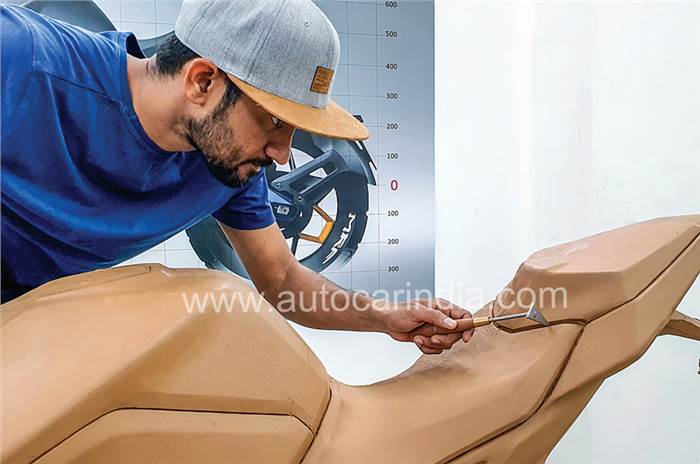
Kitna deti hai?
Well, that’s the performance addressed, but what about the bigger aspect of the battery range? The good news continues here too and while the company won’t share what the battery capacity is just yet, I’m told that the realistic range is about 150km. Even when ridden aggressively in the city and on the highway, that number shouldn’t drop below 110-120km. Charging to 80 percent will take about 45 minutes with an optional quick charger, while a full charge will take about 1 hour 10 minutes. The bike will ship with a conventional wall charger as standard, with which a full charge should take 3.5-4 hours. Ultraviolette claims that the battery pack will have a life of about 1,00,000km which is more than what most will end up using the machine.
Multi-dimensional
Happily, this EV keeps the smiles going even when the straights end and the corners arrive.
If that front end looks familiar to you, that’s because the 43mm USD fork, 320mm disc brake, four-piston radial brake caliper, Metzeler M5 tyres and even the wheels have come from the KTM 390 Duke. The production bike will get its own set of wheels, but the tyres, brakes and suspension hardware are expected to remain similar. Couple this with a sporty (but not extreme) riding position and the Ultraviolette is a peach. The bike is stable yet poised and the handling dynamics feel natural and quite light-footed. The bike turns in without much effort and the suspension setup is reminiscent of a KTM – reasonably supple, yet firm and with a clear bias towards performance.
This brake setup feels properly sharp on the 170kg RC 390, so it was no surprise that the front was super powerful on the prototype; the bite and performance will be tuned a little differently on the final machine. Naturally, I didn’t want to push the bike too much, but it never did anything nasty or unexpected and there was plenty of cornering clearance from the foot pegs. Eventually, I called myself into the pits to safely return the motorcycle when I found that I was starting to have just a bit too much fun. Of course, this is only a small taste and there’s a whole lot more to see on how it works on the public road system. But for now, it’s clear that this is a quick and engaging machine.

Space age looks?
Ultraviolette is keeping this one close to heart as well, but I managed to get them to share a teaser image of what the final bike will look like. I also got a chance to look at a VR render of the finished bike and it’s quite a good-looking thing. What you can expect is a substantial fairing around the sides, with aerodynamically designed ducts to direct air to the concealed battery pack and drivetrain. The headlamp shape is similar to the current crop of KTM street nakeds, while the rising tail section reminds me of the Suzuki GSX-S750.
I’ve also seen digital renders of a premium-looking, polished-aluminium triple-clamp for the clip-on bars and a lovely aluminium front brake caliper mount. Another big draw will be the superbike-like aluminium swingarm. The engineers could have managed fine with a simpler unit, but this one makes it to production for the visual effect, albeit cast in a single piece, unlike the prototype’s welded unit.
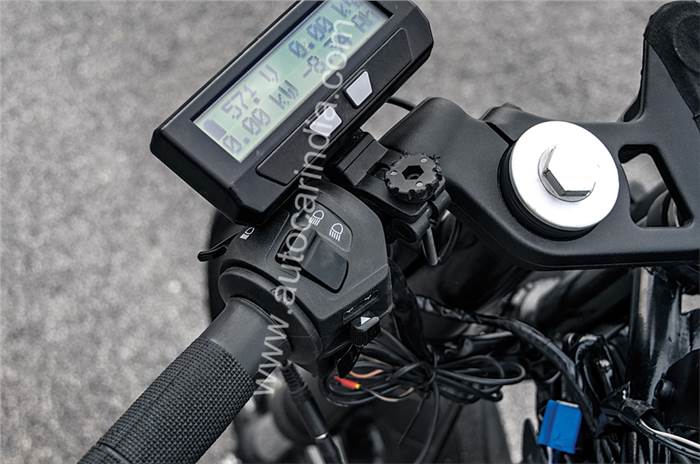
The Ultraviolette will be a smart and connected machine. Like the Ather scooters, it will be heavy on ‘connected functionality’ and, thereby, heavy on harvesting all forms of riding data. The instrument display will be a TFT colour unit, but unlike the Ather scooters, it will not be a touchscreen and will instead be controlled by buttons on the handlebar. Call me old fashioned, but that’s the smarter way to do things – touchscreens belong in your pocket, not on your motorcycle. The team stresses that the bike will be built to handle India and that all the electrics will be substantially water- and dust-proof.
Away from the connected business, the bike will offer three riding modes - Eco, Sport and Insane (I rode the bike in Sport). The rider will also be able to scroll between preset levels of regenerative braking, or turn the system off entirely. Continental dual-channel ABS will up the safety quotient, but there won’t be anything in the form of traction control at the initial stage.
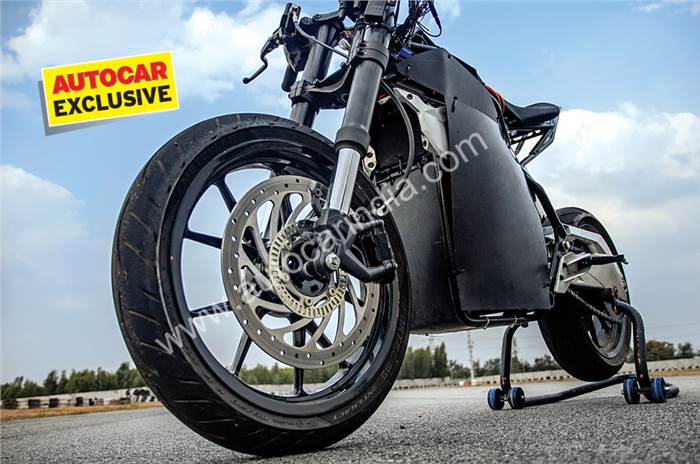
Let’s buy one already!
Hold up there. The production bike will only be launched towards the end of the year and Ultraviolette will follow a similar line of attack to Ather. Sales will begin in Bengaluru and then slowly branch out to other cities, with three planned by the end of 2020. This means that you aren’t realistically going to be able to get your hands on one for quite a while, even if you do have the good fortune of living in Bengaluru.
The company is currently evaluating production options and may even outsource manufacturing to an external entity, in the same way Apple contracts Foxconn to build its devices. Ultraviolette will also be looking at setting up a charging infrastructure in the regions that its vehicles are on sale and it will offer its customers various subscription plans.
So how much will all of this cost? It goes without saying that I don’t have a clear answer to this, but Narayan and Niraj hint that offering 200-250cc performance is as important as offering a price to match (if slightly higher) and that my estimate of Rs 2-2.5 lakh on-road is a fair one to make. Of course, some details on the final bike may change, but I think that’s perfectly reasonable for what’s promised.
Beyond that, however, I’m more intrigued that this could be the breakaway point. It’s very early in the day, but if all goes to plan, I think this bike will offer enough in terms of performance and practicality to seriously consider giving an EV a shot. Hey, that’s what Ultraviolette set out to do in the first place.
Also see:
Copyright (c) Autocar India. All rights reserved.



Comments
Member Login
Personal Details
No comments yet. Be the first to comment.